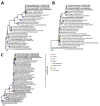Novel Zoonotic Avian Influenza A(H3N8) Virus in Chicken, Hong Kong, China
- PMID: 36037827
- PMCID: PMC9514342
- DOI: 10.3201/eid2810.221067
Novel Zoonotic Avian Influenza A(H3N8) Virus in Chicken, Hong Kong, China
Abstract
Zoonotic and pandemic influenza continue to pose threats to global public health. Pandemics arise when novel influenza A viruses, derived in whole or in part from animal or avian influenza viruses, adapt to transmit efficiently in a human population that has little population immunity to contain its onward transmission. Viruses of previous pandemic concern, such as influenza A(H7N9), arose from influenza A(H9N2) viruses established in domestic poultry acquiring a hemagglutinin and neuraminidase from influenza A viruses of aquatic waterfowl. We report a novel influenza A(H3N8) virus in chicken that has emerged in a similar manner and that has been recently reported to cause zoonotic disease. Although they are H3 subtype, these avian viruses are antigenically distant from contemporary human influenza A(H3N2) viruses, and there is little cross-reactive immunity in the human population. It is essential to heighten surveillance for these avian A(H3N8) viruses in poultry and in humans.
Keywords: Avian influenza virus; China; H3N8; Hong Kong; chicken; emergence; human; immunity; influenza; influenza virus; novel; population; respiratory infections; serology; viruses; zoonoses.
Figures

References
-
- Fouchier RA, Guan Y. Ecology and evolution of influenza viruses in wild and domestic birds. In: Webster RG, Monto AS, Braciale TJ, Lamb RA, editors. Textbook of influenza, 2nd ed. Hoboken (NJ): John Wiley and Sons; 2013. p. 175–89.
Publication types
MeSH terms
Substances
Grants and funding
LinkOut - more resources
Full Text Sources
Medical

